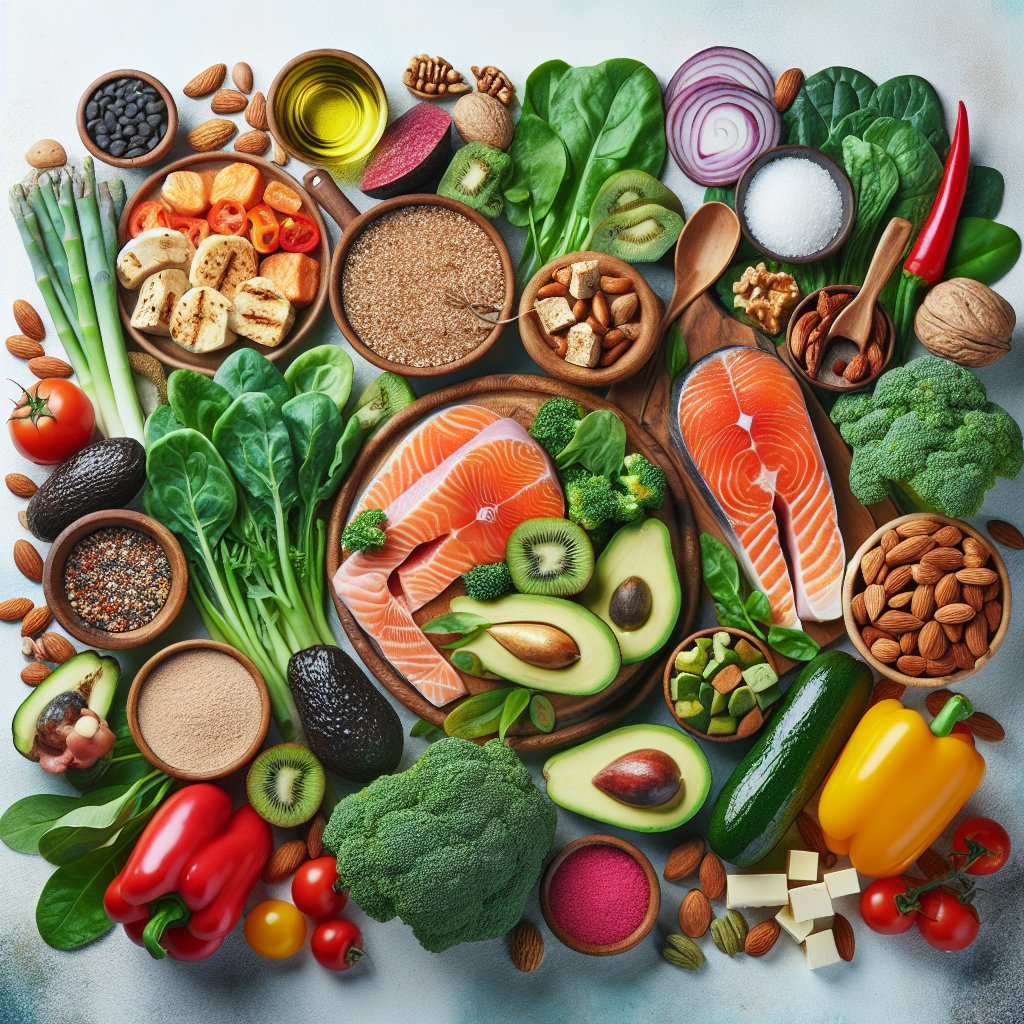Revolutionize Your Health with Keto Diabetic Recipes: Manage Diabetes with Delicious Low-Carb Meals!
Revolutionize Your Health with Keto Diabetic Recipes: Manage Diabetes with Delicious Low-Carb Meals!
Welcome to our latest blog post where we’re going to dive deep into the incredible world of keto diabetic recipes. If you’re looking for a way to revolutionize your health and manage diabetes with delicious low-carb meals, you’ve come to the right place! The ketogenic diet, or keto diet, has been gaining popularity for its numerous health benefits, and it’s particularly known for its positive impact on managing diabetes.
Understanding the Keto Diet
The keto diet is a low-carb, high-fat diet that offers various health benefits. When you restrict your carbohydrate intake and increase your consumption of healthy fats, your body enters a metabolic state called ketosis. In this state, your body becomes incredibly efficient at burning fat for energy, both from your diet and your body’s stores.
Benefits for Managing Diabetes
For individuals living with diabetes, the keto diet can be a game-changer. Research has shown that following a keto diet can improve insulin sensitivity and help regulate blood sugar levels. A study published in the journal Nutrition & Metabolism found that the keto diet led to significant improvements in glycemic control and reduced medication use in patients with type 2 diabetes.

Benefits of Keto Diet for Diabetics
If you or a loved one are living with diabetes, you know how crucial it is to manage blood sugar levels and insulin sensitivity. This is where the ketogenic diet can truly make a difference. One of the most notable benefits of a keto diet for diabetics is its ability to regulate blood sugar levels and improve insulin sensitivity.
Research has shown that following a keto diet can lead to significant improvements in glycemic control for people with type 2 diabetes. A study published in the American Journal of Clinical Nutrition found that participants following a low-carbohydrate ketogenic diet experienced greater improvements in blood sugar levels and insulin sensitivity compared to those on a traditional low-fat diet.
Furthermore, the high-fat, low-carb nature of the keto diet can help reduce the need for insulin and other diabetic medications. By minimizing the intake of carbs, the body’s reliance on glucose decreases, leading to more stable blood sugar levels and reduced insulin requirements. This not only benefits overall health but also helps manage diabetes effectively.
Importance of Low-Carb Recipes for Diabetics
When it comes to managing diabetes, the significance of low-carb recipes cannot be overstated. With the rising prevalence of diabetes globally, there is a growing need for effective dietary management strategies. Research has shown that low-carb diets can have a significant impact on managing diabetes effectively.
According to a study published in the American Journal of Clinical Nutrition, low-carb diets can lead to improved glycemic control in individuals with type 2 diabetes. The study found that participants following a low-carb diet experienced greater reductions in HbA1c levels compared to those on a high-carb diet. This indicates that low-carb recipes can play a crucial role in stabilizing blood sugar levels and managing diabetes.
Furthermore, low-carb recipes align with the principles of the ketogenic diet, which emphasizes the consumption of foods that are low in carbohydrates and high in healthy fats. By incorporating keto diabetic recipes into your meal planning, you can not only regulate blood sugar levels but also promote weight management and overall well-being.
By embracing a low-carb approach to cooking and meal preparation, individuals with diabetes can enjoy a varied and delicious array of dishes while actively managing their condition. The versatility and creativity of keto diabetic recipes make it easier than ever to maintain a balanced and fulfilling diet that supports a healthy lifestyle.

Key Principles of Keto Diabetic Recipes
Guidelines for Creating Keto Recipes Suitable for Diabetics
If you or a loved one are managing diabetes through a ketogenic diet, it’s essential to understand the key principles behind crafting recipes that support this lifestyle. Keto diabetic recipes are not only delicious but can also play a crucial role in managing blood sugar levels and overall health. Here are some essential guidelines to keep in mind when creating keto recipes suitable for diabetics:
1. Focus on Healthy Fats and High-Quality Proteins
When developing keto recipes for individuals with diabetes, it’s important to emphasize healthy fats and high-quality proteins. Research has shown that a diet rich in healthy fats, such as those found in avocados, nuts, and olive oil, can improve insulin sensitivity and help manage blood sugar levels effectively. Additionally, incorporating lean sources of protein like chicken, turkey, and fish can contribute to satiety and overall balanced nutrition.
2. Incorporate Low-Carb, Non-Starchy Vegetables
Non-starchy vegetables are a cornerstone of keto diabetic recipes. These vegetables, including leafy greens, broccoli, cauliflower, and bell peppers, are low in carbohydrates and rich in fiber and essential nutrients. Studies have demonstrated that the fiber in non-starchy vegetables can slow down the absorption of sugar and aid in maintaining steady blood glucose levels, making them an excellent choice for individuals with diabetes following a keto diet.
3. Minimize Added Sugars and Processed Ingredients
In the creation of keto diabetic recipes, it’s crucial to minimize or entirely avoid added sugars and heavily processed ingredients. High intake of added sugars has been linked to insulin resistance and heightened risk of type 2 diabetes complications. By opting for natural sweeteners like stevia or monk fruit and using whole, unprocessed ingredients, it’s possible to craft indulgent keto-friendly desserts and meals without compromising blood sugar control.
By adhering to these key principles, you can create a diverse array of keto diabetic recipes that not only contribute to better blood sugar management but also tantalize the taste buds and promote overall well-being.
Essential and Nutritious Ingredients for Keto Diabetic Recipes
Hey there, keto dieters and diabetes warriors! When it comes to crafting delicious and blood sugar-friendly keto diabetic recipes, the secret lies in the ingredients. Let’s dive into some essential and nutritious components that should make a regular appearance in your low-carb culinary adventures.
Avocado
One of the superheroes of the ketogenic diet, avocados are packed with heart-healthy monounsaturated fats and have a low impact on blood sugar levels, making them a fantastic addition to your keto diabetic recipes.
Leafy Greens
Spinach, kale, and other leafy greens are not only rich in essential vitamins and minerals but are also low in carbohydrates, making them a staple in keto diabetic recipes. They also add a delightful crunch and vibrant color to your meals.
Lean Proteins
Incorporating lean proteins such as chicken, turkey, and tofu provides the necessary building blocks for muscle maintenance and supports satiety, important for managing hunger and blood sugar levels.
Berries
While fruits are generally limited on a ketogenic diet, berries like strawberries, blueberries, and raspberries are lower in carbs compared to other fruits and can add a burst of natural sweetness and fiber to your keto diabetic recipes.
Nuts and Seeds
Packed with healthy fats and fiber, nuts and seeds such as almonds, chia seeds, and flaxseeds make excellent additions to keto diabetic recipes, adding both crunch and a dose of essential nutrients.
Coconut Oil and Olive Oil
Healthy fats are a cornerstone of the keto diet, and using coconut oil and olive oil in your cooking not only enhances flavors but also provides essential fatty acids for overall health.
Cruciferous Vegetables
Broccoli, cauliflower, and Brussels sprouts are not only low in carbs but also high in fiber and various vitamins, making them perfect for keto diabetic recipes.
So, there you have it! By making these essential and nutritious ingredients a staple in your keto diabetic recipes, you can enjoy delicious, blood sugar-friendly meals while nourishing your body with the nutrients it needs.

Sample Keto Diabetic Recipes
Managing diabetes while following the ketogenic diet can be challenging, but it’s not impossible. In fact, there are numerous delicious and easy-to-make keto recipes specifically designed for diabetics. These recipes not only help keep blood sugar levels stable but also support overall health and well-being. Here are a few scrumptious options to revolutionize your health:
Keto-Friendly Zucchini Noodles with Pesto
If you’re craving a hearty pasta dish without the excess carbs, zucchini noodles are the perfect alternative. This dish is not only low in carbohydrates but also rich in essential nutrients. Zucchini is packed with antioxidants, fiber, and vitamins. Paired with a flavorful homemade pesto made from basil, olive oil, and pine nuts, it’s a satisfying and blood sugar-friendly meal.
Spinach and Feta Stuffed Chicken Breast
This recipe is a game-changer for those looking for a protein-packed, low-carb meal. Spinach is an excellent source of magnesium and fiber, known for its positive effects on blood sugar levels. Paired with feta cheese, it’s a flavorful combination that’s sure to tantalize your taste buds. The lean protein from the chicken breast provides essential nutrients without spiking insulin levels.
Coconut Flour Pancakes
Who said diabetics can’t enjoy pancakes? These coconut flour pancakes are the ideal keto-friendly, low-carb breakfast option. Coconut flour is naturally low in carbohydrates and high in fiber, making it a suitable choice for a diabetic-friendly diet. Topped with a dollop of sugar-free whipped cream and fresh berries, it’s a guilt-free pleasure.
These recipes are not only delicious but also designed to support a diabetic-friendly keto lifestyle. By incorporating these dishes into your meal rotation, you can manage diabetes while savoring every bite!
Tips for Meal Planning on a Keto Diet for Diabetics
Meal planning for diabetic individuals following a ketogenic diet requires thoughtful consideration to ensure blood sugar management and overall health improvement. Here are some practical tips to help you successfully plan your meals:
1. Monitor Carb Intake
When planning meals, it’s essential to keep track of carbohydrate intake. High-carb foods can lead to spikes in blood sugar levels, making it crucial for diabetics to opt for low-carb alternatives. Utilize keto-friendly ingredients such as leafy greens, avocados, and nuts as the foundation of your meals. These options are nutrient-dense and won’t significantly impact blood sugar levels.
2. Prioritize Healthy Fats
Healthy fats are a cornerstone of the ketogenic diet and can be incredibly beneficial for individuals with diabetes. Incorporate sources of healthy fats such as olive oil, coconut oil, and avocado into your meal planning. These fats help stabilize blood sugar levels and promote a feeling of fullness, reducing the likelihood of overeating.
3. Include Lean Proteins
Proteins play a vital role in maintaining muscle mass and keeping you feeling satiated. When planning your meals, focus on incorporating lean protein sources such as chicken, fish, and tofu. These protein sources are low in carbs and can be prepared in various delicious ways to add variety to your meals.
By following these tips and incorporating diabetic-friendly keto recipes into your meal planning, you can effectively manage your diabetes while enjoying delicious, low-carb meals that prioritize your health and well-being.

Expert Tips for Success on Keto Diet with Diabetes
Following a keto diet while managing diabetes can be incredibly beneficial, but it does require careful planning and consideration. Here are some expert insights and tips to help you successfully navigate this journey.
Consult with a Healthcare Professional
Prior to making any major dietary changes, it’s crucial to consult with a healthcare professional, especially if you have diabetes. Your doctor or a registered dietitian can provide personalized guidance and monitor your progress to ensure that the keto diet aligns with your diabetes management plan.
Monitor Blood Sugar Levels
Regularly monitoring your blood sugar levels is essential, particularly when transitioning to a keto diet. The initial adjustment period can cause fluctuations, so it’s important to keep a close eye on how your body responds to the changes in your diet.
Focus on Nutrient-Dense Foods
When following a keto diet with diabetes, prioritize nutrient-dense foods such as leafy greens, non-starchy vegetables, lean proteins, and healthy fats. These choices can help stabilize blood sugar levels and provide essential vitamins and minerals to support overall health.
Stay Hydrated
Proper hydration is key for individuals managing diabetes, and this remains true when following a keto diet. Adequate water intake can help prevent dehydration and assist with the potential side effects of a low-carb diet, such as the keto flu.
By implementing these expert insights and tips, you can successfully manage your diabetes while reaping the benefits of a keto diet.
Conclusion: Embracing a Healthy Lifestyle with Keto Diabetic Recipes
So, there you have it – the power of keto diabetic recipes in revolutionizing the way we approach diabetes management and overall health. By incorporating these delicious, low-carb meals into our diets, we’re not only satisfying our taste buds, but also working towards a healthier, more balanced lifestyle.
The Key Points:
- Keto diabetic recipes are specifically designed to have low glycemic index and carbohydrate content, making them ideal for people with diabetes.
- These recipes emphasize whole, nutrient-dense foods, such as lean proteins, healthy fats, and non-starchy vegetables, which are essential for managing blood sugar levels.
- Research has shown that the ketogenic diet can be effective in improving insulin sensitivity and reducing the need for medication for people with type 2 diabetes.
- Consuming keto diabetic recipes can aid in weight management, which is crucial for individuals with diabetes.
The Importance of Maintaining a Healthy Lifestyle with Keto Diabetic Recipes
Maintaining a healthy lifestyle with keto diabetic recipes is vital for those looking to manage their diabetes effectively. Not only do these recipes provide a delicious and satisfying way to eat, but they also offer an array of health benefits. By focusing on nutrient-dense, low-carb ingredients, individuals can take control of their blood sugar levels and overall well-being.
By embracing this approach, individuals can work towards bettering their health and potentially reducing their reliance on medication.
Keto Diabetic Crustless Quiche Lorraine
Servings: 6
Preparation time: 15 minutes
Ingredients:
| 6 slices of bacon, chopped |
| 1 small onion, finely chopped |
| 1 cup of baby spinach |
| 1 cup of shredded Gruyere cheese |
| 6 large eggs |
| 1 cup of heavy cream |
| 1/2 teaspoon of salt |
| 1/4 teaspoon of black pepper |
| 1/4 teaspoon of nutmeg |
Instructions:
| 1. Preheat the oven to 350°F (175°C) and grease a 9-inch pie dish. |
| 2. In a skillet, cook the chopped bacon over medium heat until crisp. Remove the bacon onto a paper towel-lined plate, leaving the bacon drippings in the skillet. |
| 3. Add the chopped onion to the bacon drippings in the skillet and sauté until softened and translucent. |
| 4. Stir in the baby spinach and cook until wilted. Remove from heat and let it cool slightly. |
| 5. In a large bowl, whisk together the eggs, heavy cream, salt, pepper, and nutmeg. |
| 6. Stir in the cooked bacon, onion, spinach, and shredded Gruyere cheese. |
| 7. Pour the mixture into the greased pie dish. |
| 8. Bake for 35-40 minutes, or until the quiche is set and the top is golden brown. |
| 9. Allow the quiche to cool for a few minutes before slicing and serving. |
Nutrition facts:
| Calories | 320 kcal |
| Total Carbohydrates | 4g |
| Fiber | 1g |
| Net Carbs | 3g |
| Protein | 15g |
| Fat | 27g |


